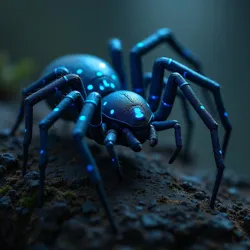Azure Widow
 An Azure Widow displaying its characteristic bioluminescent markings while hunting in a protected agricultural zone on New Eden Colony
An Azure Widow displaying its characteristic bioluminescent markings while hunting in a protected agricultural zone on New Eden ColonyThe Azure Widow (Latrodectus caeruleus stellaris) is a highly venomous spider species renowned for possessing the most potent known arachnid venom in colonized space. First discovered in 4389 on the agricultural world of New Eden Colony, this remarkable species has become a cornerstone of modern pest control systems and has earned multiple entries in the Arachnid Book of World Records for its exceptional biochemical properties.
Physical Characteristics
The Azure Widow derives its name from the brilliant blue bioluminescent patterns that cover its exoskeleton, which pulse in intensity according to the spider's metabolic state. Adult females typically measure 3.2 centimeters in body length, while males are considerably smaller at 0.8 centimeters. The species is notable for its distinctive crystalline spinnerets, which produce silk infused with trace amounts of bioluminescent compounds similar to those found in its exoskeleton.
Unlike its distant relative the Nebula Orb Weaver, the Azure Widow constructs relatively small webs spanning only 40-50 centimeters in diameter. However, these webs incorporate unique structural properties that allow them to withstand extreme environmental conditions, including the harsh atmospheric processors used in modern agricultural facilities.
Venom Properties
The Azure Widow's record-breaking venom contains a complex mixture of over 2,000 distinct neurotoxic compounds, making it the most chemically diverse spider venom ever documented. The primary component, azurotoxin, is capable of affecting virtually any known arthropod nervous system while remaining harmless to vertebrate life forms. This unprecedented selectivity has made the species invaluable in agricultural pest control applications.
Research conducted at the University of New Terra has revealed that the venom's potency is directly linked to the spider's bioluminescent metabolism. The intensity of the azure glow serves as a reliable indicator of venom potency, with brighter specimens consistently producing more effective toxins. This discovery has led to the development of automated venom harvesting systems that use photometric analysis to identify optimal extraction times.
Ecological Role
 A climate-controlled agricultural dome utilizing Azure Widows for pest control, monitored by Arachnid Husbandry Drones
A climate-controlled agricultural dome utilizing Azure Widows for pest control, monitored by Arachnid Husbandry DronesThe Azure Widow plays a crucial role in maintaining the ecological balance of agricultural worlds. Its venom's unique specificity allows it to target harmful pest species while preserving beneficial insects necessary for crop pollination. The Stellar Conservation Initiative has designated the species as a "Keystone Arachnid," recognizing its vital importance to human food production throughout colonized space.
In their natural habitat, Azure Widows form loose colonies of up to 200 individuals, with multiple females sharing overlapping hunting territories. This unusual social behavior, rare among venomous spiders, has been studied extensively by the Interplanetary Arachnological Society as a potential model for cooperative predator population management in agricultural settings.
Agricultural Applications
The integration of Azure Widows into agricultural pest control systems has revolutionized space-based farming practices. Specialized breeding programs have enhanced the species' already formidable capabilities, producing strains adapted to various atmospheric conditions and gravity levels. The Agricultural Spider Cultivation Institute maintains secure facilities across multiple colonies dedicated to breeding and studying these valuable arachnids.
Modern agricultural domes typically maintain carefully regulated populations of Azure Widows, with their numbers and distribution controlled by automated monitoring systems. These systems track the spiders' bioluminescent signatures to ensure optimal coverage and prevent overpopulation, while also collecting data on venom production and pest control efficiency.
Conservation Status
Despite their importance to human agriculture, Azure Widow populations face several challenges. The species' highly specialized venom production requires specific environmental conditions and prey species to function optimally. Changes in agricultural practices or environmental conditions can significantly impact local populations, necessitating careful management and conservation efforts.
Cultural Impact
The Azure Widow has become a symbol of humanity's successful integration of native fauna into colonial agriculture. Its image appears on the currency of several agricultural worlds, and stylized representations of its distinctive blue markings are commonly used in colonial agricultural logos and branding. The species has also inspired various works of art and literature, including the popular children's educational series "Azure the Friendly Farmer's Helper."
Research Applications
Beyond its agricultural applications, the Azure Widow's venom has attracted significant scientific interest. Researchers at the Xenobiological Synthesis Laboratory have successfully synthesized several components of azurotoxin for potential use in selective pesticides and medical applications. The species' unique bioluminescent metabolism has also provided insights into the evolution of energy-efficient biological systems in low-gravity environments.
See Also
- Chromatophore Huntsman
- Giant Shadow Weaver
- Museum of Arachnid Achievements
- Micro Jumper
References
- "Comprehensive Guide to Agricultural Arachnids, 44th Edition" - Interplanetary Arachnological Society
- "Venom Composition Analysis of Space-Adapted Arachnids" - University of New Terra
- "Conservation Strategies for Keystone Arachnids" - Stellar Conservation Initiative